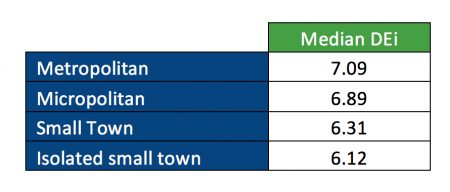The Rural Broadband Digital Divide
There is a high degree of awareness of how differences in Internet connectivity contribute to the “digital divide” experienced by many, if not most, rural areas. Less is understood about a very real divide that exists from (a lack of) utilization. That’s right, just as important as “speed” is how much businesses and non-commercial organizations utilize the Internet.
Using the data SNG has collected in numerous states between 2012 and February 2015, we can actually quantify this digital divide. Just as significantly, we can identify the types of organizations (industry, size, rural/urban, etc.) that are experiencing the greatest gap in utilization. To quantify utilization, SNG has developed a means to measure utilization we call the Digital Economy index (DEi) that is a reflection of how many Internet processes or applications an organization uses. We measure use of 17 applications on a ten-point scale (ten being best) to develop the DEi (e.g. an organization using 8 of 17 applications would have a DEi score of 4.7).
 Collecting data in numerous states, each with rural and urban components, SNG has uncovered the digital divide that exists based largely on the size of the community businesses are located. The table on the right shows that the more urban a community, the higher the DEi score. Regardless of speed available, rural communities are utilizing the Internet and its applications at a lower rate largely because in rural areas there is less knowledge transfer amongst peers and less of a market for specialized technical services.
Collecting data in numerous states, each with rural and urban components, SNG has uncovered the digital divide that exists based largely on the size of the community businesses are located. The table on the right shows that the more urban a community, the higher the DEi score. Regardless of speed available, rural communities are utilizing the Internet and its applications at a lower rate largely because in rural areas there is less knowledge transfer amongst peers and less of a market for specialized technical services.
Beyond the notable gap in Internet utilization between rural and urban areas, SNG’s research also reveals sectors and types of organizations that suffer most from this digital divide. This is consistent with our findings that rural communities have far less local resources to support businesses looking to better utilize broadband applications.
For small towns & isolated small towns (in essence, the census terms for “rural”), local governments have the largest utilization gap compared to their metropolitan peers: with a DEi of 5.24 compared to 7.17. Libraries also show a notable utilization gaps: metro = 7.23; rural = 6.12). In contrast, K-12 schools of comparable size have very similar DEi scores regardless of how urban or rural they are.
 When examining industry type, it is illuminating to see just how much variance there can be depending on industry. Ironically, one of the biggest utilization gaps is in what might be considered the most advanced sector (Professional and Technical Services) which is large, growing, and well paying but slow to adopt key Internet applications.
When examining industry type, it is illuminating to see just how much variance there can be depending on industry. Ironically, one of the biggest utilization gaps is in what might be considered the most advanced sector (Professional and Technical Services) which is large, growing, and well paying but slow to adopt key Internet applications.
 Larger businesses in rural areas (100 or more employees) still experience a utilization gap to their urban counterparts. Rural businesses with less than 100 employees experience a much larger utilization gap.
Larger businesses in rural areas (100 or more employees) still experience a utilization gap to their urban counterparts. Rural businesses with less than 100 employees experience a much larger utilization gap.
So while fiber, net neutrality, and FCC decisions dominate the news, the success of broadband in driving impacts is dependent on utilization.
This means that providing our rural businesses with the knowledge and support to leverage the Internet is key to maintaining competitiveness. Furthermore, in today’s landscape it is easier to live rural and work globally, as long as rural businesses have access to networks and support systems that help them thrive in the digital economy. Developing local networks and supports is a direct and significant opportunity (as well as challenge) for local business retention and growth. There are ways to achieve this, including SNG’s Small Business Growth Program. We’d love to share with you how this program can drive economic growth in your region.



